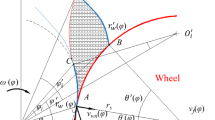Abstract
In the grinding process of crankshafts, the grinding parameters were improperly selected, which easily caused the high temperature in the grinding zone and led to burns on the crankshaft journal surface. To address this issue, referencing previous studies, the suitability of the Gaussian heat source model was verified by comparing it with three different heat source models. The Gaussian heat source model was applied to predict the temperature on the surface of the crankshaft connecting rod journal. Transient thermal analysis and investigation of material phase transformation were employed to explore the mechanism of grinding burns. The interaction effects among grinding parameters were analyzed using the Box-Behnken design, and a multiple linear regression equation was established for response surface optimization. The results demonstrated that applying the Gaussian heat source model and response surface optimization yielded the optimal solution, with a maximum deviation of 1.37% between the simulation and optimization results. By selecting a grinding depth (ap) of 0.40 mm, wheel speed (vs) of 40.00 m/s, and feed rate (vx) of 0.036 mm/s as the processing parameters, the temperature in the grinding zone was reduced to 659.37 °C, effectively mitigating grinding burns.











Similar content being viewed by others
Data availability
All necessary data are shown in the figures and tables within the document. The raw data can be made available upon request.
References
Jaeger JC (1942) Moving sources of heat and the temperature at sliding contacts. Proc Roy Soc New South Wales 76:203
JiYao B (1964) Analysis and study of grinding temperature. J Shanghai Jiaotong Univ 3:55–71
Rowe WB (2001) Temperature case studies in grinding including an inclined heat source model. Proc Inst Mech Eng Part B J Eng Manuf 215(4):473–491
Jin T, Rowe WB, McCormack D (2002) Temperatures in deep grinding of finite workpieces. Int J Mach Tool Manuf 42(1):53–59
Songyong L, Gang Y, Jiaqiang Z, Xiaohui L (2015) Numerical and experimental studies on grind-hardening cylindrical surface. Int J Adv Manuf Technol 76:487–499
Yan W, Jianhu X, Jianguo L, Sheng Z (2015) Research on finite element simulation of temperature field based on Rayleigh distribution in surface grinding. Zhongguo Jixie Gongcheng 26(04):484–490
Dexian W, Peiqi G, Wenbo B, Chuandong Z (2015) Heat source profile in grinding zone. Xi'an Jiaotong Daxue Xuebao 49(08):116–121
Manchao Z. (2016) Dynamic behaviors in orbital grinding of crankshaft pin and their influence on precision and surface integrity. PhD Thesis, Shanghai Jiao Tong University, China
Lin B, Zhou K, Guo J, Liu QY, Wang WJ (2018) Influence of grinding parameters on surface temperature and burn behaviors of grinding rail. Tribol Int 122:151–162
Urgoiti L, Barrenetxea D, Sánchez JA, Pombo I, Álvarez J (2018) On the influence of infra-red sensor in the accurate estimation of grinding temperature. Sensors 18(12):4134
Changfe L, Haolin L (2011) The study of external cylindrical grinding force and power model. Mod Manuf Eng 12:72–75
Qi HS, Rowe WB, Mills B (1997) Contact length in grinding: part 2: evaluation of contact length model. Proc Inst Mech Eng Part J J Eng Tribol 211(1):77–85
Xiumin Z, Shichao X, Shiyu W (2015) Effect of grinding fluid parameters on microstructure damage of grinding hardening surface. Dongbei Daxue Xuebao, Ziran Kexueban 36(10):1491–1495
Dequn K, Xinjian K (2016) Analysis of grinding burn crack of 18CrNiMo7-6 steel gear. Metal Work 19:20–24
Funding
The study supported this work on the Influence of J08E Crankshaft Technology and Structure Design on Crankshaft strength (Grant No. CD22111X).
Author information
Authors and Affiliations
Contributions
All authors contributed to the idea and design of this study. The initial idea of this paper was provided by Qiuyun Mo. The data collection, model building, and parameter optimization was done by Siyuan Wang. The first draft of the manuscript was written by Siyuan Wang. All authors revised the first few versions of the manuscript, read and approved the final manuscript carefully.
Corresponding author
Ethics declarations
Ethics approval
The authors state that this paper is an original work; it has not been published in any journals, and this research does not involve any ethical issues of humans or animals.
Consent to participate
All authors are aware and satisfied with the authorship order and correspondence of the paper.
Consent for publication
All the authors have consented to publication and have been approved by the institutions to which this work belongs.
Competing interests
The authors declare no competing interests.
Additional information
Publisher’s Note
Springer Nature remains neutral with regard to jurisdictional claims in published maps and institutional affiliations.
Rights and permissions
Springer Nature or its licensor (e.g. a society or other partner) holds exclusive rights to this article under a publishing agreement with the author(s) or other rightsholder(s); author self-archiving of the accepted manuscript version of this article is solely governed by the terms of such publishing agreement and applicable law.
About this article
Cite this article
Wang, S., Mo, Q., Li, L. et al. Research and process optimization of crankshaft grinding parameters based on Gaussian heat source model. Int J Adv Manuf Technol 132, 601–611 (2024). https://doi.org/10.1007/s00170-024-13331-2
Received:
Accepted:
Published:
Issue Date:
DOI: https://doi.org/10.1007/s00170-024-13331-2




